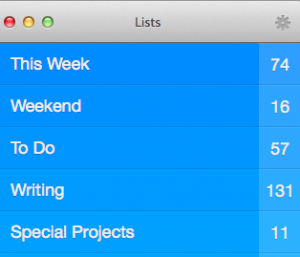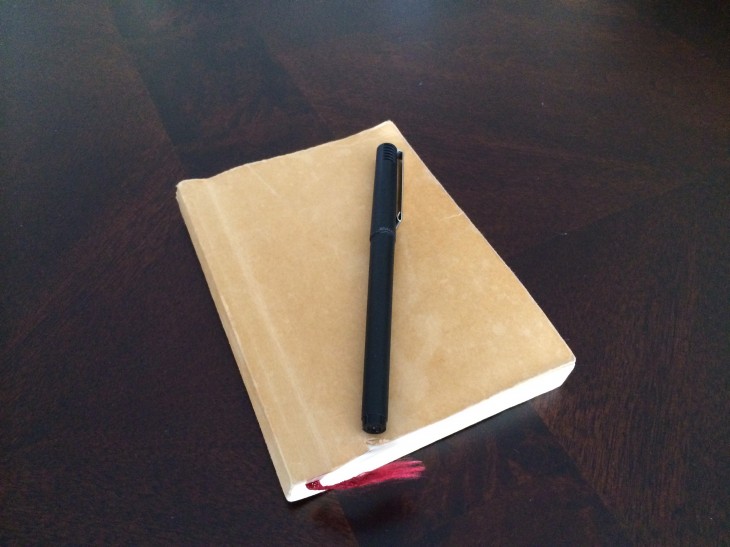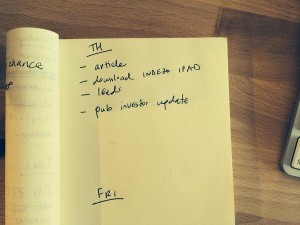
Mikael Cho is the co-founder of Crew, a network that connects short-term software projects with handpicked developers and designers. This post originally appeared on the Crew blog.
As our company grows, so does the to-dos. It gets harder to prioritize what needs to be done on any given day.
In the morning, I might have my day’s tasks lined up but suddenly a few things happen and everything changes. Priorities shift. What I thought was most important a few seconds ago, no longer is.
By the middle of the day, my to-do list can look like a messy pile of clothes in a Wal-Mart “for sale” bin.
It’s overwhelming.
I had been using the Clear app on my phone and my desktop computer because it allowed me to sync all my tasks no matter where I was. It worked great for me when I had fewer daily tasks but with more items and the constant shifting in priorities, it no longer did the trick.
Here’s a snapshot of how I was trying to manage my growing list of over 250 to-dos:
Also, having this to-do list app open in the background of my computer gave me a constant reminder that I had lots of things to get to. As the list grew longer, it hurt my ability to focus on creative tasks and was a source of anxiety.
A couple weeks ago, I decided to switch up how I manage my to-do list.
I kept using Clear to manage my long-term to-dos but for my daily list I switched back to something I used throughout grade school – a pen and a notebook.
When I started writing my to-dos down on paper, I felt a sense of control.
Psychology John Medina wrote in his book Brain Rules, about how the brain is a sequential processor, meaning that the brain can only run a single task to completion before starting a new one. This means the brain cannot multitask.
Even if you think you’re good at multitasking, you’re likely just better than others at switching between tasks. Everyone’s brain must go through a similar 4-step process each time you switch to a new task. You might be able to go through this “switching process” faster than someone else but we all must go through this same process.
Focus is a fragile thing. Just having my to-do list peeking at me behind my current window on my computer, seemed to create a form of multitasking in my brain.
Digital clutter is as bad as physical clutter
When I started writing my to-dos on paper, the separation from the digital space (where I do most of my work) to the physical, helped me feel less overwhelmed.
As Mark Hurst, author of Bit Literacy, a New York Times best seller on controlling the flow of information in the digital age put it,
“Bits are a new material.”
Although an extra app open in the background may not seem like much, it effects your concentration. It has been largely supported that humans can hold an average of seven plus or minus two bits of information in our working memory to dedicate to a current task.
This means, for every tab or app you have open, you’re potentially depleting your ability to perform the current task by more than 10 percent.
Each tab or app you have open is a form of interruption. Moving your to-do list to a different medium from where you do work helps separate it from your working memory.
Your to-do list should not be a source of decision fatigue
We all have a limited number of “decision-making points” in a day. When you wake up in the morning, you start with a full glass. As the day goes on, each decision you make – from deciding what to wear to what you should eat for lunch – your glass starts to empty. Each decision you need to make hurts your ability to make your next decision a good one.
One recent study found that people were nearly twice as likely to choose an unhealthy cake over a healthier bowl of fruit after being asked to remember a seven-digit sequence of numbers compared to an easier 2-digit sequence.
An unorganized to-do list forces you to make too many unnecessary decisions. It depletes precious resources that you could be dedicating to problem solving or more creative tasks.
Paper and pen forces you to decide what’s important
Writing your to-do list on paper has it’s limits, but that’s not always a bad thing. Researchers at Princeton and UCLA recently found that taking notes by hand versus on a laptop helped students retain more information because taking notes forces you to actively listen and decide what’s important.
Similarly, writing your to-dos down by hand, in a limited space like a notebook, forces you to actively decide what’s most important.
Having a digital to-do list allows you to list an infinite number of things (which works great for remembering things like meetings and writing down tasks you need to eventually do) but is less than ideal for organizing a daily list that shifts frequently and has to be completed in a finite time.
I’ve noticed that whatever actions I put on my to-do list, it roughly averages out to about an hour a task. Some tasks might take 2 hours while others take 30 minutes. So I aim to put about 5 to-dos down to start the day and let the rest of my to-do list fill up with things that become priorities.
David Heinemeier Hansson, Creator of Ruby on Rails and Founder at Basecamp said he “only plan(s) for 4-5 hours of real work per day” because things will inevitable come up.
This stuck with me as a piece of advice that I think about when I prepare what I’m going to do in a day.
I constrain the space to write my to-do list by using a half a page to write today’s list down. To force myself to stay within this space constraint, I write the next day halfway down the page. This allows me to fit a maximum of about 10 items in my daily list.
I start each day with the most impactful thing on my list. Which means even if for whatever reason I don’t get to all the other items, at least I did the most important thing.
An added benefit of writing down to-dos on paper is you get to see those items crossed off. This might not seem like a big deal but research shows that simply seeing items crossed off triggers the release of the feel-good hormone dopamine, helping you feel accomplished and motivated.
Before writing my to-dos down and constraining my list to half sheet of paper, I would experience some form of disappointment at the end of each day because I didn’t get through all my tasks. This was a shitty way to feel. I want to feel good at the end of a good day’s work. Not like crap.
You’re constantly flooded with decisions and information fighting for your fragile attention. By applying some of these changes to how you manage your daily to-dos, hopefully your to-do list will be one less thing competing for your brain’s precious resources.
Get the TNW newsletter
Get the most important tech news in your inbox each week.







